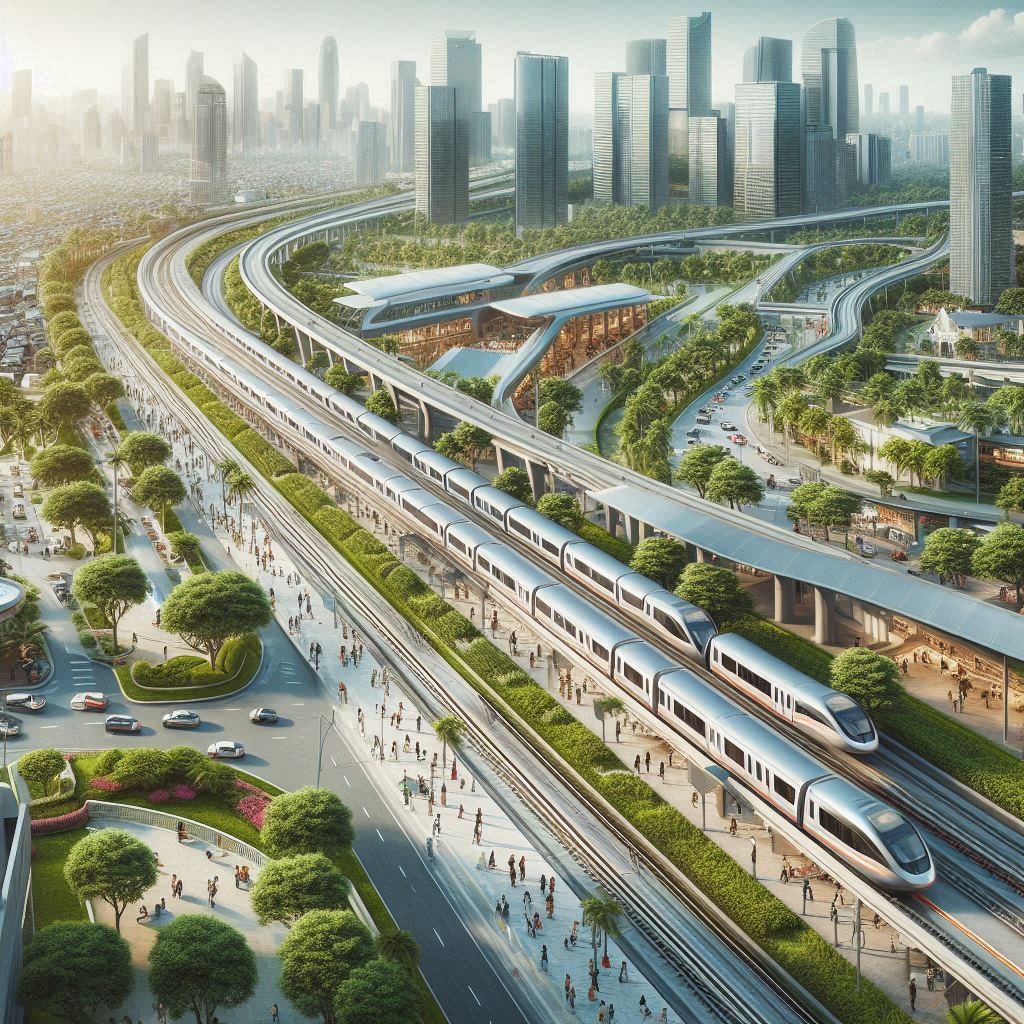Why have we allowed our rail networks to stagnate?
Few modes of transport have shaped the modern world like the railway. From the Industrial Revolution to today’s high-speed networks, rail systems have been the silent engines of economic growth, urban development and social connectivity. Now, as the world confronts the twin challenges of climate change and rapid urbanisation, rail is being reimagined not as a relic of the past, but as a key driver of a more sustainable, resilient future. However, we have to ask the question – why have rail networks in so many countries been allowed to stagnate, while so many others are prospering, writes John Ridgeway?
Across the globe, nations are waking up to the transformative potential of modern rail networks - investing billions to upgrade capacity, cut emissions and connect underserved regions. Yet this revival is far from universal. While countries like China, Japan and Spain are expanding sleek high-speed lines and digital control systems, others, including Germany and the U.S., are struggling with outdated infrastructure, chronic delays and years of underinvestment. This divide is reshaping the global rail landscape and raising critical questions about the role of rail in the 21st century.
Rail is among the lowest carbon-emitting forms of transport, particularly when electrified. Governments aiming for net zero are investing in rail as a cleaner alternative to highways and air travel. As a mass transit solution that aligns with smart city principles, rail is a key tool for shifting freight away from heavy trucking.
Countries like India, Spain, France and the Netherlands are pushing for 100% rail electrification. Hydrogen and battery-powered trains are also being trialled in places like Germany and the UK, further reducing dependence on diesel.
China now operates over 40,000 km of high-speed lines, more than the rest of the world combined. It continues to expand its network both domestically and internationally via its Belt and Road Initiative.
Japan remains a leader in high-speed reliability and safety with its Shinkansen system and Europe is increasing connectivity across borders, with countries like France, Germany and Italy investing in cross-national links.
Digital transformation
The rail sector is modernising through digital control systems, predictive maintenance using IoT and automated operations. Driverless metros are becoming common in cities like Copenhagen, Dubai, and Vancouver. However, despite the momentum, rail is not without its obstacles.
In many places, particularly in parts of the UK, US and Eastern Europe, rail infrastructure is aging. Signals are outdated, often running on 20th-century tech, stations and rolling stock are overdue for upgrades - and capacity is constrained, with bottlenecks and limited flexibility for growth.
While the benefits of rail are well-documented, it remains capital-intensive. Building or modernising rail lines can take billions in investment and years to complete, which often deters political will or leads to project delays.
Rail systems in wealthier countries are surging ahead, while some developing nations remain reliant on outdated or limited infrastructure. Even within developed countries, rural and regional lines are often neglected, leaving large gaps in access and coverage.
Despite these issues, rail presents a massive opportunity if approached strategically. Integrating freight and passenger networks could optimise use and reduce logistics costs. Green public procurement can reduce emissions across construction and operation. Intermodal connections (rail + bike, rail + bus, rail + air) can create seamless, user-friendly journeys and smart railways equipped with real-time data and AI can prevent delays, improve safety and increase capacity without necessarily laying new tracks.

For years, it seemed like rail might be sidelined, overshadowed by the convenience of air travel and the flexibility of personal vehicles. But fast-forward to 2024/2025 and rail is undergoing a quiet renaissance. Far from being a relic of the past, rail is shaping the future, both in cities and across nations.
The backbone of sustainable transport
With the world racing toward net-zero emissions, rail stands out as one of the most climate-friendly transportation modes. Electrified rail lines emit far fewer greenhouse gases than cars, buses, or planes and trains use less land and energy per passenger or tonne of freight compared to highways or air corridors.
As countries crack down on urban pollution and fossil fuel dependency, rail becomes a natural solution - not a legacy system to be phased out, but a foundation to build on. In short, rail supports the kind of mode shift that cities and countries desperately need to hit climate targets. Moving people and goods from roads to tracks is not just an option - it’s a necessity.
The global disruptions of recent years, for example, pandemics, wars, supply chain shocks, extreme weather, have all highlighted the fragility of just-in-time logistics and car-centric planning. Rail offers greater control over national infrastructure, unlike volatile international shipping routes, together with energy security, particularly for countries that electrify their systems and reduce diesel dependence. Furthermore, as extreme climate events damage roads and delay flights, rail has proven more adaptable and less vulnerable in many cases.
In cities, rail is critical to making life more affordable, more equitable and more human-centric. Mass transit systems are proven to reduce congestion and commute times, lower the cost of living by connecting people to jobs and housing across wider areas, improve air quality and reduce noise pollution and enable car-light or even car-free lifestyles, especially when paired with cycling and pedestrian infrastructure.
From Paris’s Grand Paris Express to Lagos’s Blue Line, metros and light rail systems are transforming how people move and live, bringing cleaner, faster, more reliable transport to millions.
Rail as a catalyst for innovation
Rail is not just about old tracks and stations, it’s a frontier of innovation, with cutting-edge technologies reshaping what trains can do. Hyperloop concepts and vacuum tube transport, though still early-stage, are testing speeds beyond 600 mph. Autonomous trains are in service or testing in cities like Hamburg and metros across China.
Hydrogen and battery-powered trains are already replacing diesel in non-electrified regions, with countries like Germany and the UK leading the way and AI and predictive analytics are being used for maintenance and scheduling, reducing downtime and increasing safety. The rail industry is also investing heavily in passenger experience, from high-speed Wi-Fi and real-time journey planning to fully integrated mobility-as-a-service (MaaS) platforms.
In a world facing environmental, economic, and social turbulence, rail provides stability, scalability and long-term value - and governments are responding. The EU’s Green Deal earmarks rail as a pillar of sustainable transport and India’s National Rail Plan aims to shift 45% of freight to rail by 2030.
The U.S. Infrastructure Investment and Jobs Act includes billions for rail modernisation and expansion and China continues to build out the largest high-speed rail network in history, improving internal mobility and exporting rail tech abroad.
Germany's national railway operator, Deutsche Bahn (DB), has proposed an additional €150 billion investment to revitalise and expand the country's rail infrastructure. Of this, €80 billion is earmarked for repairing and refurbishing the existing network, addressing years of underinvestment that have strained the system. The remaining funds aim to expand the network, including new routes, station enlargements, and the introduction of advanced rail technologies. This initiative comes amid financial pressures, with DB reporting a net debt of €32.6 billion in 2024.
The Biden-Harris administration announced over $2.4 billion in funding for 122 rail improvement projects across 41 states and Washington, D.C. This investment focuses on making rail travel safer, more reliable, and resilient, aiming to reduce disruptions, lower shipping costs, and decrease pollution. This may of course now be in doubt under the Trump administration.
China and Vietnam have agreed to assess the feasibility of developing two new railway lines, marking a significant step in infrastructure cooperation. This includes updating century-old rail routes and constructing a new line along their shared coast. China will fund feasibility studies for two of the lines, with studies to be completed within a year after contractor selection.
The United States has also pledged an additional $600 million towards the Lobito Corridor railway project in Angola, bringing its total investment to $4 billion. This initiative aims to refurbish nearly 2,000 kilometres of railway, improving access to critical minerals like cobalt and copper from Congo and Zambia, essential for electric vehicle batteries and clean energy technologies
Despite its historical significance in railway development, the UK's rail system faces challenges due to outdated infrastructure. Recent disruptions caused by faults in the nationwide radio system highlight the need for modernisation. Additionally, hundreds of trains operated by Northern Rail are suffering from corrosion, with many not scheduled for replacement for another five years
Commuters into New York City have experienced severe train delays and cancellations, with the exact causes remaining unidentified. Factors such as century-old tracks, aging trains, extreme heat and high demand contribute to the challenges faced by Amtrak and New Jersey Transit.
In January 2024, a collision near Cicalengka Station in Bandung resulted in four deaths and 42 injuries. The incident was attributed to an uncommanded signal leading to a false clear, caused by aging hardware. This tragedy underscores the urgent need for modernising signalling systems and infrastructure.
All this means that rail systems worldwide are at a crossroads, with some regions embracing modernisation and others struggling with legacy challenges. Strategic investments, technological innovation and a commitment to sustainability are essential for revitalising rail infrastructure. As countries recognise the pivotal role of rail in economic development and environmental stewardship, a concerted global effort is necessary to ensure that railways continue to serve as vital conduits for progress.
Additional Blogs

How construction can cut Its carbon footprint by caring for soil
Soil is often dismissed as mere dirt, but it is one of the planet’s most powerful carbon stores, holding more than all of the world’s forests combined. Yet in our rush to build, pave and develop, we...
Read moreWhat is bridging damp? How it happens and how to fix it
Bridging damp happens when moisture finds a path around the building’s damp-proof course (DPC) so it reaches your internal walls and skirting. If you see damp patches rising above the skirting or...
Read more

The silent death of the fixed-price contract
For decades, the fixed-price contract has been the backbone of construction procurement. It promised certainty with a defined scope, an agreed sum and a clear transfer of risk from client to...
Read more